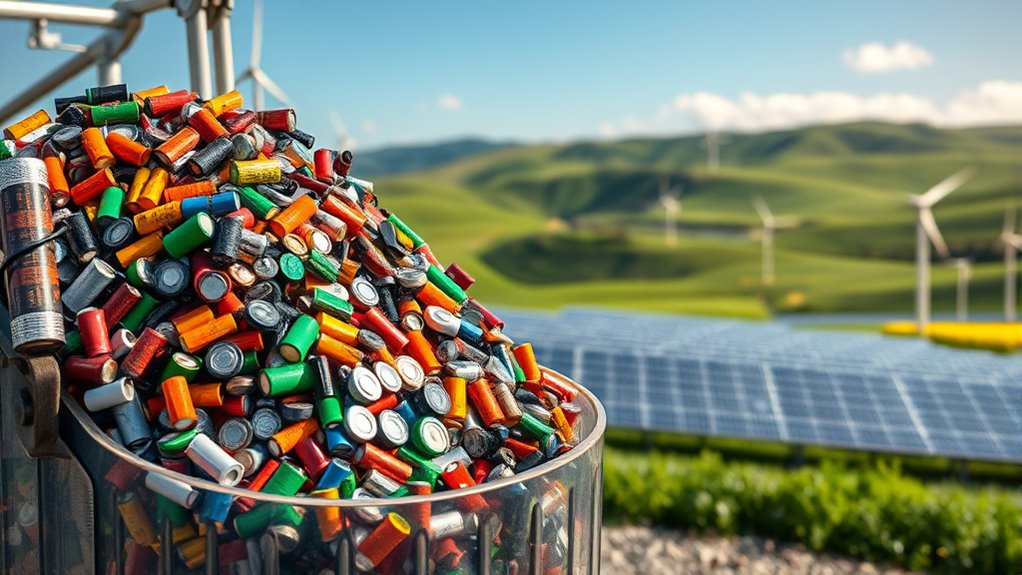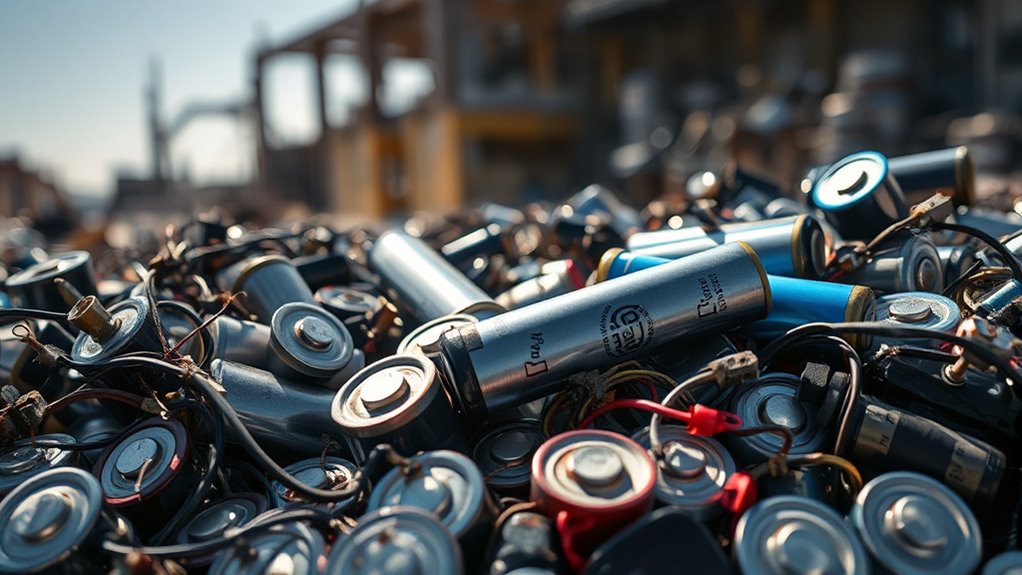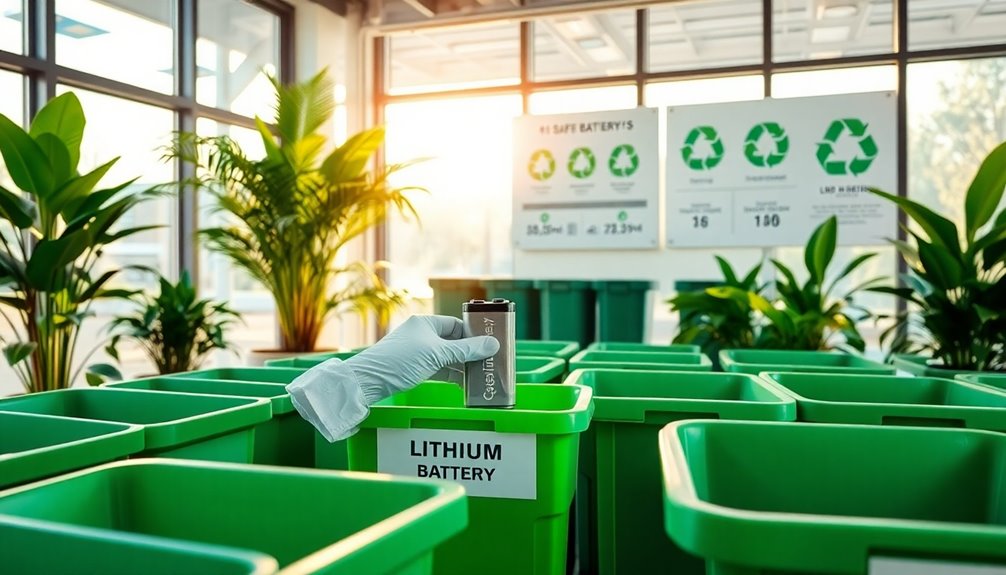Recycling batteries is vital for a successful energy shift because it helps you maximize resource use and reduce environmental harm. By reusing EV batteries, you extend their life and lower dependence on new raw materials, preventing ecological damage from mining. Recycling also creates a more resilient supply chain, cutting costs, and supporting sustainable practices. Keep exploring to discover how these innovations are shaping a cleaner, greener future for everyone.
Key Takeaways
- Recycling extends battery lifespan, maximizing resource use and reducing waste in the energy transition.
- It creates a sustainable, closed-loop supply chain, decreasing reliance on raw material mining.
- Recycling reduces environmental risks by containing hazardous materials and preventing soil and water contamination.
- Technological innovations improve recycling efficiency, supporting a circular economy for batteries.
- Repurposing used batteries for energy storage lowers costs and accelerates the adoption of clean energy solutions.

As the world shifts toward cleaner energy sources, battery recycling plays a crucial role in supporting the changeover. One of the key ways this happens is through the development of second life batteries. These are used EV batteries that, after their initial purpose, can still store and deliver energy effectively for less demanding applications like home energy storage or grid stabilization. By repurposing these batteries, you extend their lifespan, maximize resource use, and reduce the need for new raw materials. This not only lowers costs but also helps mitigate the environmental impact associated with mining and processing materials like lithium, cobalt, and nickel. Second life batteries serve as a bridge in the energy transition, allowing you to make the most of existing resources and delay the need for new manufacturing. Additionally, integrating high-efficiency recycling methods ensures that valuable materials are recovered more completely, further supporting sustainable practices.
Second life batteries extend EV battery life, reduce raw material needs, and support sustainable energy transition.
Moreover, battery recycling is essential for guaranteeing supply chain sustainability. As demand for lithium-ion batteries skyrockets with the growth of electric vehicles and renewable energy storage, the pressure on raw material supplies intensifies. Without robust recycling processes, you risk creating a supply chain that’s heavily dependent on geopolitically sensitive regions and environmentally damaging extraction methods. Recycling helps close the loop by recovering valuable materials from spent batteries, reducing reliance on mining and importing new raw materials. This creates a more resilient and localized supply chain, less vulnerable to disruptions, price fluctuations, and resource depletion. For you, this means a more stable, predictable supply of essential materials, ultimately supporting large-scale deployment of clean energy technologies.
The importance of battery recycling extends beyond just resource conservation. It plays a critical role in minimizing hazardous waste. Batteries contain toxic chemicals and heavy metals, which, if not properly recycled, can leach into soil and water, causing environmental harm. Recycling ensures these substances are safely contained and repurposed, reducing ecological footprints and protecting communities. It also aligns with broader sustainability goals, demonstrating your commitment to responsible energy practices.
Furthermore, advancements in recycling technologies are making the process more efficient and cost-effective. When you participate in or support these innovations, you contribute to a more sustainable energy ecosystem. This progress not only boosts the economics of battery reuse and recycling but also encourages the development of second life batteries, creating a circular economy within the energy sector. Ultimately, integrating recycling into the battery lifecycle guarantees that your transition to electric and renewable energy is as sustainable, resilient, and environmentally friendly as possible.
Frequently Asked Questions
How Does Lithium Extraction Impact Local Communities?
Lithium extraction can critically impact local communities by affecting environmental health, such as water contamination and habitat disruption. You might notice changes in community health, including respiratory issues or water shortages, due to mining activities. These environmental impacts often lead to social tension and economic challenges. It’s essential to address these concerns through sustainable practices to protect both the environment and the well-being of local residents.
What Are the Safety Concerns in Battery Recycling Facilities?
You might think battery recycling is perfectly safe, but hazardous materials pose real fire safety risks. Handling chemicals like lithium and cobalt can lead to dangerous fires if not managed properly. Safety concerns include chemical leaks, explosions, and toxic fumes. It’s ironic that what’s meant to help the environment can become a hazard itself if facilities neglect proper safety protocols, emphasizing the need for strict procedures and trained personnel.
Can Recycled Batteries Meet the Performance Standards of New Ones?
Yes, recycled batteries can meet the performance standards of new ones. Advances in recycling efficiency help recover key materials, maintaining battery lifespan and ensuring high performance. You’ll find that modern recycling processes preserve the integrity of lithium, cobalt, and other essential components, allowing recycled batteries to perform reliably. Continuous improvements in technology mean recycled batteries are increasingly comparable to new ones, supporting a sustainable and efficient energy progression.
How Cost-Effective Is Large-Scale Battery Recycling Currently?
Large-scale battery recycling is becoming increasingly cost-effective thanks to economic viability improvements and technological advancements. You’ll find that as recycling processes become more efficient, costs decrease, making it more competitive with new battery production. Innovations in sorting, material recovery, and automation help lower expenses, ensuring that recycling not only benefits the environment but also offers a financially sustainable solution. This progress supports a more circular economy and accelerates the energy shift.
What Policies Are Needed to Promote Global Battery Recycling Efforts?
You need strong policies to promote global battery recycling. International collaboration is essential to create unified standards and share best practices, ensuring consistency and efficiency. Establish clear regulatory frameworks that incentivize recycling, such as mandates and subsidies, to motivate manufacturers and consumers. When governments work together, they can develop innovative solutions, reduce environmental impact, and accelerate the energy shift—making battery recycling a truly global effort that benefits everyone.
Conclusion
By embracing battery recycling, you’re helping to steer the energy shift smoothly and sustainably. It’s like giving old batteries a graceful encore, allowing their valuable materials to shine once more. This gentle cycle keeps resources in play and reduces environmental strain, ensuring a brighter, cleaner future. So, next time you think about batteries, remember that recycling isn’t just a choice — it’s a subtle step toward a more harmonious energy world.










